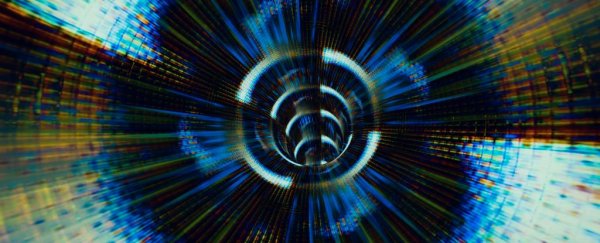Scientists have figured out how to create a new type of sonic boom using light instead of sound, and it's opened up a more efficient way to convert energy into beams of light.
Why would someone want to convert perfectly good energy into light? Well, our current computers run on plain old energy, and they've about hit their peak in terms of how much processing power we can jam into their chips. Light-based computers, on the other hand, could theoretically process data at the speed of light, and this new sonic boom could be how we finally do it.
First off, a little background info on light-based computers. Like quantum computers, light-based computers are being developed in response to the inevitable - and fast-approaching - demise of the electron-based computer that you're reading this on right now.
Our current computers transmit data via electrons, and the speed at which that data can be transmitted is limited by the time it takes for these electronics to travel between the processor and the memory.
It's gotten to the point now, where if we want data to go faster, we need a medium that travels faster than electrons - so why not something that literally travels at the speed of light? While the idea of replacing electrons with light particles - or photons - sounds pretty simple, it's actually anything but.
As we explained back in September, running current computers on light instead of electricity would speed up the rate at which we could transmit data, but our current silicon chips still require the photons to be converted back to electrons to be processed.
This means everything would need to be slowed back down again to allow for the conversion, and the system would consume a whole lot of extra energy in the process. So a system that converts light to electrons would be even less efficient than one that uses only electrons! [conundrum intensifies]
Not that that's going to stop scientists and engineers from trying, because nailing light-based computers would quite literally revolutionise how we process data, and change the foundations of computing forever. (Permission to get hype, just a little.)
A team from MIT has just announced a new solution to the whole 'conversion problem', and it involves creating a kind of 'shockwave' of light. It's similar, in theory, to the shockwave and "boom" sound created by an aeroplane as it hits speeds faster than the speed of sound, and creates a sonic boom shockwave.
As David L. Chandler explains for MIT News, the researchers figured out that they could use a sheet of graphene - that 1-atom-thick 'wonder material' that everyone keeps talking about - to allow the flow of an electric current to overtake slowed-down light particles to produce an intense, focused beam of light. Or an optical boom, as they like to call it.
The team reports in Nature Communications that this is an entirely new way of converting electricity into visible radiation, and it's highly controllable, fast, and efficient.
So how does it work? The team observed that when light comes in contact with a two-dimensional sheet of graphene, it slows down dramatically - by a factor of a few hundred. What was more intriguing is the fact that the speed that these slowed-down photons were now travelling was almost exactly the same as the speeds travelling by the electrons.
Turns out, graphene coincidentally slows down light and speed up electrons to about the same speed.
"This effect dovetailed with another of graphene's exceptional characteristics: electrons pass through it at very high speeds, up to a million metres per second, or about 1/300 the speed of light in a vacuum. That meant that the two speeds were similar enough that significant interactions might occur between the two kinds of particles, if the material could be tuned to get the velocities to match."
The team says this could lead to a whole new way of generating light, because just as breaking the sound barrier generates a shockwave of sound, getting electrons and photons to travel at roughly the same speeds leads to a shockwave of light, trapped in two dimensions.
"This conversion is made possible because the electronic speed can approach the light speed in graphene, breaking the 'light barrier'," says one of the team, Marin Soljačić.
In terms of getting this technology into the light-based computers of the future, the team says we're talking operating speeds "six orders of magnitude higher than what is used in electronics" - or up to a million times faster.
So… what's the catch? This entire process hinges on graphene, and you know what they say - graphene is the material that can do anything… except leave the lab. Graphene is notoriously expensive to produce, and if we want it to be the basis of light-based computer chips, that's something scientists are going to have to figure out.
But progress is being made - six months ago, scientists announced that they'd figured out how to make graphene 100 times more cheaply than ever before. We've still go a long way to go, but no one's giving up on this light-based computer hype-train just yet.
